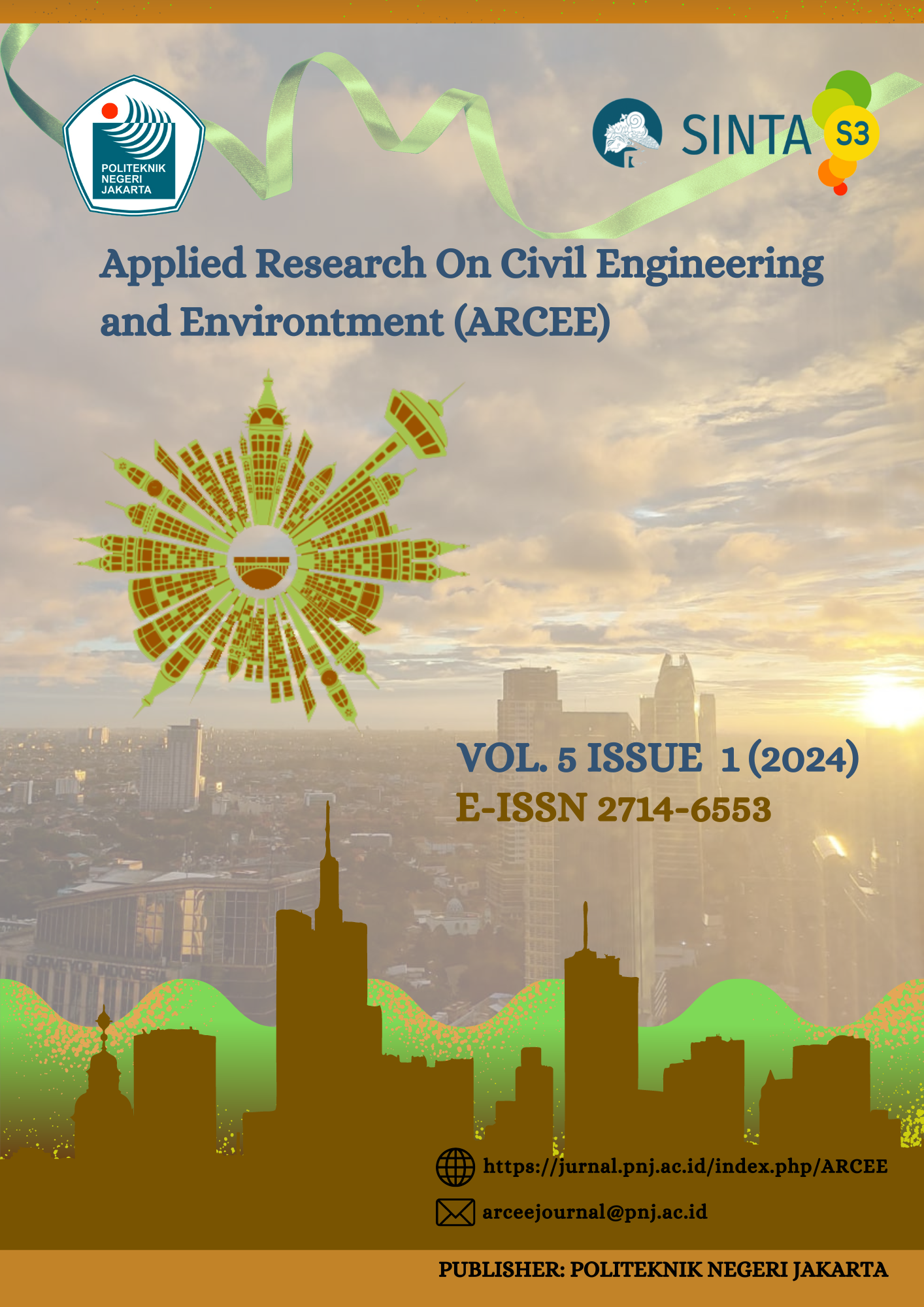EXPERIMENTAL STUDY ON STEEL AND POLYPROPYLENE FIBERS MORTAR BOND STRENGTH UNDER UNIAXIAL TENSION
##plugins.themes.academic_pro.article.main##
Abstract
The present study aims to investigate the bond behavior between fibers and mortar matrix in fiber-reinforced concrete, which was explored through a uniaxial tension test. The bond behavior was studied for different types of embedded fibers: steel fibers, polypropylene fibers, and hybridizations of steel and polypropylene fibers. The mixture proportion was determined based on the absolute volume method with a water-to-binder ratio (w/b) of 0.29 to achieve high-strength mortar. The high-strength mortar was cast by utilizing an industrial waste by-product of both silica fume and fly ash as a partial cement replacement. The compressive strength and uniaxial tension tests on high-strength mortar were conducted at the ages of 28 and 140 days. The long-term bond-strength behavior was investigated at the age of 140 days. The results showed that the average compressive strengths of hardened mortar on 28 and 140 days were 54.82 MPa and 69.37 MPa, respectively. Whereas, the average fiber-mortar bond strengths with steel, polypropylene, and hybridized fibers were 8.62 MPa, 8.37 MPa, and 7.30 MPa, respectively, at 28 days and 11.22 MPa, 10.21 MPa, and 11.82 MPa, respectively, at 140 days. Compared to the equivalent bond strength of the steel fiber, the polypropylene fiber had an equivalent bond strength of 2.90% and 9.00% lower at the ages of 28 and 140 days. Meanwhile, the equivalent bond strength of hybridized fiber was 15.31% lower than that of steel fiber; however, the long-term behavior of the hybridized fiber showed its performance was about 5,35% higher than that of steel fiber at 140 days.
##plugins.themes.academic_pro.article.details##

This work is licensed under a Creative Commons Attribution-ShareAlike 4.0 International License.
References
- Abdallah, S., Fan, M., & Rees, D. W. A. (2018). Bonding Mechanisms and Strength of Steel Fiber–Reinforced Cementitious Composites: Overview. Journal of Materials in Civil Engineering, 30(3). https://doi.org/10.1061/(ASCE)MT.1943-5533.0002154
- ASTM C33/C33M-18. (2018). Standard Specification for Concrete Aggregates. West Conshohocken, ASTM International.
- ASTM C109/C109M. (2021). Standard Test Method for Compressive Strength of Hydraulic Cement Mortars (Using 2-in. or [50-mm] Cube Specimens). West Conshohocken, ASTM International.
- ASTM C128-15. (2015). Standard Test Method for Relative Density (Specific Gravity) and Absorption of Fine Aggregate. West Conshohocken, ASTM International.
- ASTM C188-16. (2016). Standard Test Method for Density of Hydraulic Cement. West Conshohocken, ASTM International.
- ASTM C494-17. (2017). Standard Specification for Chemical Admixtures for Concrete. West Conshohocken, ASTM International.
- ASTM C1240-20. (2020). Standard Specification for Silica Fume Used in Cementitious Mixtures. West Conshohocken, ASTM International.
- Bhargava, P., Sharma, U. K., & Kaushik, Surendra. K. (2006). Compressive Stress-Strain Behavior of Small Scale Steel Fibre Reinforced High Strength Concrete Cylinders. Journal of Advanced Concrete Technology, 4(1), 109–121. https://doi.org/10.3151/jact.4.109
- Chao, S.-H., Naaman, A. E., & Parra-Montesinos, G. J. (2009). Bond Behavior of Reinforcing Bars in Tensile Strain-Hardening Fiber-Reinforced Cement Composites. ACI Structural Journal, 106(06). https://doi.org/10.14359/51663191
- Ding, X., Zhao, M., Li, C., Li, J., & Zhao, X. (2021). A multi-index synthetical evaluation of pullout behaviors of hooked-end steel fiber embedded in mortars. Construction and Building Materials, 276, 122219. https://doi.org/10.1016/j.conbuildmat.2020.122219
- Fu, C., Guo, R., Lin, Z., Xia, H., Yang, Y., & Ma, Q. (2021). Effect of nano silica and silica fume on the mechanical properties and microstructure of lightweight engineered cementitious composites. Construction and Building Materials, 298, 123788. https://doi.org/10.1016/j.conbuildmat.2021.123788
- Liao, W.-C., Perceka, W., & Liu, E.-J. (2015). Compressive Stress-Strain Relationship of High Strength Steel Fiber Reinforced Concrete. Journal of Advanced Concrete Technology, 13(8), 379–392. https://doi.org/10.3151/jact.13.379
- Liao, W.-C., Perceka, W., & Yu, L.-C. (2017). Systematic Mix Procedures for Highly Flowable-Strain Hardening Fiber Reinforced Concrete (HF-SHFRC) by Using Tensile Strain Hardening Responses as Performance Criteria. Science of Advanced Materials, 9(7), 1157–1168. https://doi.org/10.1166/sam.2017.3097
- Liu, C., Zhang, Y., Yao, Y., & Huang, Y. (2019). Calculation method for flexural capacity of high strain‐hardening ultra‐high performance concrete T‐beams. Structural Concrete, 20(1), 405–419. https://doi.org/10.1002/suco.201800151
- Naaman, A. E., & Najm, H. (1991). Bond-Slip Mechanisms of Steel Fibers in Concrete. ACI Materials Journal, 88(2). https://doi.org/10.14359/1896
- Ou, Y.-C., Tsai, M.-S., Liu, K.-Y., & Chang, K.-C. (2012). Compressive Behavior of Steel-Fiber-Reinforced Concrete with a High Reinforcing Index. Journal of Materials in Civil Engineering, 24(2), 207–215. https://doi.org/10.1061/(ASCE)MT.1943-5533.0000372
- Perceka, W., Liao, W.-C., & Wang, Y. (2016). High Strength Concrete Columns under Axial Compression Load: Hybrid Confinement Efficiency of High Strength Transverse Reinforcement and Steel Fibers. Materials, 9(4), 264. https://doi.org/10.3390/ma9040264
- Perceka, W., Liao, W.-C., & Wu, Y.-F. (2019). Shear Strength Prediction Equations and Experimental Study of High Strength Steel Fiber-Reinforced Concrete Beams with Different Shear Span-to-Depth Ratios. Applied Sciences, 9(22), 4790. https://doi.org/10.3390/app9224790
- Tavares, L. R. C., Junior, J. F. T., Costa, L. M., da Silva Bezerra, A. C., Cetlin, P. R., & Aguilar, M. T. P. (2020). Influence of quartz powder and silica fume on the performance of Portland cement. Scientific Reports, 10(1), 21461. https://doi.org/10.1038/s41598-020-78567-w
- Thomas, J., & Ramaswamy, A. (2007). Mechanical Properties of Steel Fiber-Reinforced Concrete. Journal of Materials in Civil Engineering, 19(5), 385–392. https://doi.org/10.1061/(ASCE)0899-1561(2007)19:5(385)
- Xu, B. W., Ju, J. W., & Shi, H. S. (2011). Progressive Micromechanical Modeling for Pullout Energy of Hooked-end Steel Fiber in Cement-based Composites. International Journal of Damage Mechanics, 20(6), 922–938. https://doi.org/10.1177/1056789510385260

